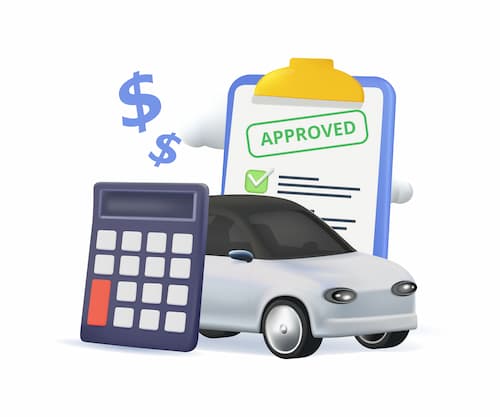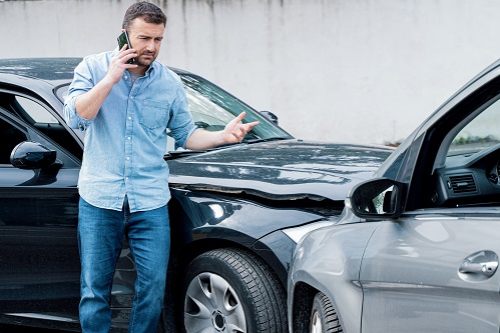- What is uninsured/underinsured motorist coverage?
- When do uninsured and underinsured motorist coverage apply?
- What does uninsured motorist coverage cover?
- How much does uninsured motorist insurance cost?
- How does uninsured/underinsured motorist coverage work?
- Types of uninsured/underinsured motorist coverage and limits
- Stacking uninsured motorist and uninsured motorist bodily injury insurance
- How to file an uninsured/underinsured motorist claim
- Are uninsured motorist and uninsured motorist bodily injury coverages required?
- How much uninsured motorist coverage do I need?
- Uninsured motorist rates by state: What's your risk level?
What is uninsured/underinsured motorist coverage?
Uninsured/underinsured motorist coverage (UM/UIM) is a coverage that covers your injuries and damages when the at-fault driver has no insurance or not enough insurance.
| Uninsured motorist | Underinsured motorist |
|---|---|
| The driver did not buy insurance, or their insurance has lapsed | The driver has insurance, but it's not enough to cover the entire claim |
| Driver is on the road illegally and has no coverage | Driver is on the road legally and may have state minimum coverage |
"Let's say you're driving to the store today, and some 19-year-old [without insurance] plows into the side of your car," says Dave Emmette, chief operating officer and risk advisor at River Valley Insurance in Lowell, Michigan. "That's the type of scenario that plays out across the country every day, and in many cases, those who are hit by an uninsured driver may find they are stuck with expensive medical bills and other costs."
When do uninsured and underinsured motorist coverage apply?
Uninsured motorist coverage kicks in when:
- The at-fault driver has no car insurance
- The other driver's insurance company denies their claim or can't pay it
- The driver leaves the scene and can't be located (hit-and-run), although this may only apply to injuries
Underinsured motorist coverage kicks in when:
- The driver has at least the minimum insurance required by law, but it isn't enough to cover the damage
People ask
Do I need uninsured motorist coverage if I have collision and comprehensive coverage?
While there is some overlap between what collision coverageCollision coverage helps pay for repairs or replacement of your car if it's damaged in an accident, regardless of who is at fault and is subject to a deductible. and uninsured motorist cover, only uninsured motorist provides bodily injury coverage when you are struck by an uninsured driver.
What does uninsured motorist coverage cover?
There are two types of uninsured/underinsured motorist coverage:
- Uninsured/underinsured motorist bodily injury coverage. This covers injuries caused by an uninsured or underinsured motorist who is at fault for the accident.
- Uninsured/underinsured motorist property damage coverage. This covers property damage done by an uninsured or underinsured motorist.
If you carry both, then you'll have protection for both medical bills resulting from an accident with an uninsured or underinsured driver and the damage they do to your car or property.
Does uninsured motorist insurance cover a hit-and-run?
UM/UIM may cover damage to your car from a hit-and-run. The following states will not allow drivers to use UMPD coverage for hit-and-run damage:
- California
- Colorado
- Georgia
- Illinois
- Louisiana
- Ohio
In these states, collision coverage is required for damage to your car.
How much does uninsured motorist insurance cost?
The average cost of uninsured/underinsured motorist coverage is $199 a year. Bear in mind that most insurance companies will require you to carry the same limits for UM/UIM as your liability limits.
The best way to see what UM/UIM insurance will cost you is to compare car insurance quotes from several companies.
How does uninsured/underinsured motorist coverage work?
To illustrate how uninsured/underinsured motorist coverage works, let's take the hypothetical example of a driver we'll call Jade.
Jade lives in Arizona, where the state minimum liability limits are 25/50/15, but she carries uninsured/underinsured motorist coverage equal to her liability limits of 100/300/100.
Jade's car is sideswiped by another vehicle and she crashes into the median. She's lucky to sustain only minor injuries, but her $45,000 car is a total loss.
The other driver carries only the state minimum, which means their insurance will only pay a maximum of $15,000 for Jade's car.
She files a claimAn insurance claim is a request you make to your insurance company for coverage after your car is damaged or you have an accident. You can file a claim online, by phone, or in writing. against her underinsured motorist coverage, which pays the balance of her car's value. Without UIM insurance, Jade would have been out of pocket by $30,000.
This may differ if you're dealing with an injury claim, especially in a no-fault state where your personal injury protectionPersonal injury protection (PIP) pays for your medical, hospital and funeral expenses resulting from a car accident, regardless of who's at fault. (PIP) will apply first to your medical bills.
If the other driver has no insurance at all, however, you will need to work solely with your own insurance company for an uninsured motorist claim.
Types of uninsured/underinsured motorist coverage and limits
In states offering uninsured or underinsured motorist property damage coverage, consumers may have the choice to buy UM/UIM insurance as a split limit or combined single limitCombined single limit (CSL) auto insurance policies have a single liability payment limit for both property damage and bodily injury. policy.
- Split limit plans have separate coverage levels for UMBI and UMPD. For example, they may be written as $50,000/$100,000/$25,000, providing coverage of $50,000 per person, subject to a maximum of $100,000 per accident for bodily injury and 25,000 for property damage.
- Combined single limit plans are offered in a small number of states, where one coverage level can pay for both UMBI and UMPD. For instance, a $100,000 policy will pay for up to that amount of UM claims, regardless of whether or not they are related to bodily injury or property damage.
Combined single limit policies are more flexible, but split limit plans may be less expensive.
Furthermore, in some states you can purchase just uninsured motorist coverage separately from underinsured motorist.
Stacking uninsured motorist and uninsured motorist bodily injury insurance
In some, but not all, states, you can elect to stack your uninsured motorist bodily injury and/or underinsured motorist bodily injury coverage. Here's how it works:
- In a two-vehicle household where each vehicle has UMBI limits of 100/300, the maximum payout is $100,000 per person and $300,000 per incident.
- With stacked UMBI coverages, the limits would double to 200/600.
In general, there is no limit on the number of vehicles that can be insured with stacked UMBI coverage. If you only have one car on your policy, then stacking is not an option for you, but if you have multiple vehicles, stacking can be one of the perks of multi-car insurance.
Even if your state allows stacking, not all car insurance companies offer the option.
People ask
Is there a deductible for uninsured motorist?
Sometimes. It depends on your state and your insurer. In some states, there is no deductible, while in others there is a deductible, but the state limits how much it can be. Additionally, insurance companies may have their own guidelines for deductibles.
How to file an uninsured/underinsured motorist claim
If you have been in an accident, even if you think the other party is at fault, you should immediately call your own insurance company. Filing a claim with your insurer for the accident is the first step to using your uninsured or underinsured motorist coverage.
Until the full cost of the damages is known, you won't know if the other driver has enough insurance. However, if they have no insurance, your insurer can take steps right away to process an uninsured motorist claim.
People ask
What is the difference between uninsured and underinsured motorist coverage?
The difference between UM and UIM is when each coverage applies. Uninsured motorist coverage pays when you are struck by another driver with no insurance at all, while underinsured motorist coverage pays when you are struck by a driver who does have insurance, but whose limits aren't sufficient to cover the damage.
Are uninsured motorist and uninsured motorist bodily injury coverages required?
UM and UIM coverage is voluntary in more than half of U.S. states, but some do require it. The following chart lists the states with uninsured drivers' insurance requirements and indicates the type of coverage that is mandated.
State requirements are shown for uninsured motorist, bodily injury (BI), uninsured motorist property damage (UMPD) coverage, and underinsured motorist property damage (UMIPD) coverage, along with required coverage limits.
States with UM and/or UIM requirements
| State | Insurance required | Minimum liability limits |
|---|---|---|
| Connecticut | BI & PD Liability, UM, UIM | 25/50/25 |
| Washington, D.C. | BI & PD Liability, UM | 25/50/10 |
| Illinois | BI & PD Liability, UM, UIM | 25/50/20 |
| Kansas | BI & PD Liability, PIP, UM, UIM | 25/50/15 |
| Maine | BI & PD Liability, MED, UM, UIM | 50/100/25 |
| Maryland | BI & PD Liability, PIP, UM, UIM | 30/60/15 |
| Massachusetts | BI & PD Liability, PIP, UM | 20/40/5 |
| Minnesota | BI & PD Liability, PIP, UM, UIM | 30/60/10 |
| Missouri | BI & PD Liability, UM | 25/50/25 |
| Nebraska | BI & PD Liability, UM, UIM | 25/50/25 |
| New Jersey | BI & PD Liability, PIP, UM, UIM | 25/50/25 |
| New York | BI & PD Liability, PIP, UM, UIM | 25/50/10 |
| North Carolina | BI & PD Liability, UM, UIM | 50/100/50 |
| North Dakota | BI & PD Liability, PIP, UM, UIM | 25/50/25 |
| Oregon | BI & PD Liability, PIP, UM, UIM | 25/50/20 |
| South Carolina | BI & PD Liability, UM | 25/50/25 |
| South Dakota | BI & PD Liability, UM, UIM | 25/50/25 |
| Vermont | BI & PD Liability, UM, UIM | 25/50/10 |
| Virginia | BI & PD Liability, UM, UIM | 50/100/25 |
| West Virginia | BI & PD Liability, UM | 25/50/25 |
| Wisconsin | BI & PD Liability, UM | 25/50/10 |
*Required if policyholder chooses to purchase limits higher than $25,000/$50,000.
Only 22 states and the District of Columbia have UM and/or UIM coverage requirements. Insurance mandates appear unrelated to the estimated percentage of uninsured motorists by state. Whether or not you add UM/UIM coverage may depend on the cost; be sure to consider whether or not you can afford to go without this important and inexpensive insurance.
How much uninsured motorist coverage do I need?
In general, you should have uninsured motorist limits equal to your liability limits.
"If your bodily injury limit is $500,000, your uninsured coverage should be the same," Emmette says. What's more, some insurers may limit you to UM coverage that is no greater than your other liability limits.
Uninsured motorist rates by state: What's your risk level?
Nationwide, 15.4% of drivers are uninsured. However, in some states, that number is a lot higher.
Take a look at the states with the highest and lowest rates of uninsured drivers, based on the most recent Insurance Information Institute data, below.
| Rank | State | Percent uninsured |
|---|---|---|
| 1 | Mississippi | 28.2%% |
| 2 | New Mexico | 24.1% |
| 3 | Washington, D.C. | 23.1% |
| 4 | Michigan | 22.3% |
| 5 | Tennessee | 21.3% |
| 6 | Missouri | 20.7% |
| 7 | Florida | 20.6% |
| 8 | California | 20.4% |
| 9 | Colorado | 19.5% |
| 10 | Washington | 19.1% |
| Rank | State | Percent uninsured |
|---|---|---|
| 1 | Maine | 5.7% |
| 2 | Utah | 6.2% |
| 3 | Idaho | 6.4% |
| 4 | Wyoming | 6.7% |
| 5 | Montana | 7.2% |
| 6 | West Virginia | 7.8% |
| 7 | Massachusetts | 7.9% |
| 8 | New York | 8.6% |
| 9 | South Dakota | 9.4% |
| 10 | Nebraska | 9.5% |



